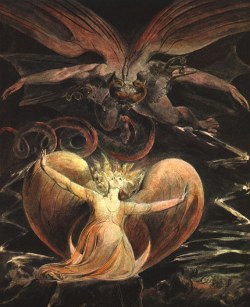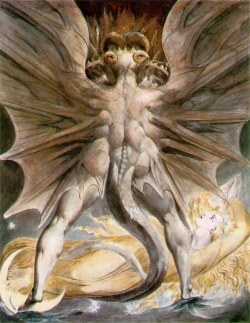 Two of Blakes' Red Dragon paintings
|
The
style of the meeting between the FBI agent and Lecter is
quite different in Manhunter. In this version, Dr Lecter
sits in a small white cell, barely large enough for his
bed and a toilet, everything totally devoid of color,
with all clinically white appointments except for some
offsetting gray. Lecter: Why should I help you? You think you are smarter than me. agent: I know that I'm not smarter than you Lecter: Then how did you catch me? agent: You had disadvantages. Lecter: What disadvantages? agent: You're insane. This Doctor Lecter is far subtler than Hopkins' version, far more restrained. No remarking on the proper wine to eat with FBI flesh, no strange facial expressions, no violence. He is a master manipulator, shown as staying above the violence he is supposed to be capable of. A man with a god complex. Hopkins went for over-the-top to create a memorable character. Brian Cox skipped all the grandstanding and went for icy calculation, never saying or doing anything except to direct his own agenda. One of his vicious tricks was to find a way to send the FBI agent's home address to the killer! The crimes are also portrayed in a very subtle way. The FBI agent sees the crime scene after the bodies have been removed, and our imaginations conceive far greater grotesqueries than any which the filmmaker could have pictured. There are also scenes where we see the killer being compassionate and gentle with his blind lover, and then we feel his pain when he sees her with another man, imagining love glowing from their embrace. Extraordinary depth of characterization for the bad guy. Graham, the FBI agent, is assigned to the case because of his unique talent to project himself into killers' mind-sets and recreate the way the killers think. He dictates his notes into a tape machine as the film progresses. He says of the killer, "my heart bleeds for him as a kid. Somebody took a kid and manufactured a monster. At the same time, as an adult he's irredeemable. He butchers entire families to pursue trivial fantasies. As an adult, someone should blast the sick fuck out of his socks." Agent Graham is played intensely by a guy who should have become a star somewhere along the way, but never did, William L Petersen. |
||||
|
It is a
moody, ultra-creepy movie in the hands of Michael Mann
(The Insider, Miami Vice). You may have noticed that
Mann's favorite stylistic audio device, besides spooky
rock music, is to let a single musical chord linger
beneath a scene until its sound disappears from the ears.
The sustained chords lend a special eerie quality to
nearly every scene, even the scenes that are not
superficially supposed to be creepy, like the lovemaking
between the FBI agent and his wife. By doing this, Mann
lets us feel the tension that the agent cannot ever
escape while he dwells inside a killer's mind on the one
hand, while being terrorized by Dr Lecter on the other. Many film lovers wonder why this brilliant, ultra-stylish film faded into obscurity while Demme's became a cultural landmark. Sidebar: Here is a list of the real people upon whom these characters are based. |
||||
|
|||||

